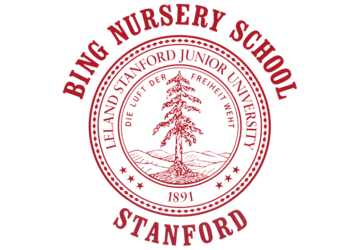
By Jade Arellano, Teacher
Bing Nursery School staff members consistently work to cultivate an environment that nurtures a curiosity and passion for learning. On Feb. 18, Bing hosted a staff development day where staff reflected on the curriculum, ongoing research in child development at Bing, and the power of creative movement.
Nancy Verdtzabella, head teacher in West PM, began the day with a presentation on emergent curriculum in outdoor environments. Emergent curriculum is a teaching philosophy in which the teacher tailors the curriculum to the children’s interests as they arise. She posed the question of how educators can make outdoor spaces more intriguing for children: “What happens when the outdoor environment is viewed as a place for in-depth learning?” She illustrated how aesthetically pleasing, ecologically diverse natural spaces offer children the opportunity to form a relationship with the environment through their senses. In one instance, children were able to process the devastating impact of the Northern California wildfires through dramatic play in the redwood grove in the yard: As imaginary firefighters, the children showed that they were able to organize and collaborate and demonstrated a deep concern for the state of the world. Noticing that fire was a recurring theme in the children’s play, Verdtzabella provided markers and paper, which the children then used to create props that further enriched their exploration of fire. Here, close observation of the children’s play formed the basis of an emergent curriculum that facilitated a thoughtful and empathetic engagement with the outdoors, where the children used their immediate outdoor surroundings to empower themselves as members of a larger society experiencing a crisis.
Following Verdtzabella, Alexandra Carstensen discussed the development of relational reasoning in a presentation titled “Early Diversity in Abstract Thought.” Carstensen is a postdoctoral fellow working with psychology professor Michael Frank in the Language and Cognition Lab at Stanford. Her current research at Bing examines the roles of language and culture in children’s early reasoning about abstract ideas like causes, relations and space. To learn more about Carstensen’s work, see page 7.
The next presentation was given by Emily Lake, a PhD candidate in linguistics at Stanford and a Ric Weiland Graduate Fellow. Like Carstensen, Lake is interested in language, but she focuses more on how children vary their speech in social interactions. Lake analyzed recordings of interviews, conversations, and a matching game she played with the children. She found that children pronounce words slightly differently based on their social groupings within the classroom. This correlation between the children’s speech and their preferences in play suggests that nuanced differences in language are socially meaningful to even very young children: “It is important because it suggests that the children are important members of linguistic communities and not just passively absorbing language patterns from their parents.”
To close the day, Mara Beckerman, the music and movement specialist at Bing, led the staff in a series of open-ended movement exercises to demonstrate the power of creative movement in the classroom. Beckerman started studying modern dance at the age of 8 and cites dance as a central influence on how she processes her life experiences. Rather than directing young children to move in set ways, Beckerman prefers guiding them to “explore and discover the many ways their bodies move naturally.” The movements that Beckerman used in the workshop and applies in the classrooms are largely inspired by Anne Green Gilbert’s “Brain Dance,” which is a series of eight movements that humans do naturally during our first year of life. Beckerman emphasized the importance of being creative when describing new movements; for example, she explained how the idea of “bubble space” helps children visualize and understand personal space by imagining their bodies as being surrounded by a bubble that will “pop” if they come into contact with another. She also demonstrated the use of objects to teach movement––staff found an unexpected source of inspiration in the colorful scarves that Beckerman distributed, twisting them and whirling them through the air, and then mimicking one another’s movements. The scarves have certainly become a staple of movement exploration at Bing, where children can be seen dancing in a whirl of colors across the sun-soaked yards.